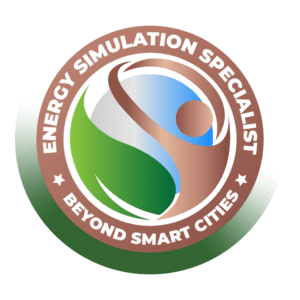Energy Simulation of High Performance Green Buildings
This course introduces the conceptual and technical core aspects of whole-building energy simulation. Students will learn to use energy modelling or simulation, the underlying principles of energy modeling, and the ASHRAE 90.1 Appendix G modelling methodology.
Building Energy Modeling simulates building energy use physics-based. A Building Energy Modeling programme uses geometry, construction materials, lighting, HVAC, refrigeration, water heating, and renewable generation system designs, component efficiencies, and control strategies to describe a building. It also records occupancy, lighting, plug- loads, and thermostat schedules. These inputs, local weather data, and physics equations determine thermal loads, system response to those loads, energy use, and related metrics like occupant comfort and energy costs in a BEM application.
Energy modelling simulates a building’s energy consumption, utility bills, and life cycle costs of energy-related items like air conditioning, lights, and hot water. It calculates the payback of green energy solutions like solar panels, photovoltaics, wind turbines, and high-efficiency appliances.
Building energy consumption has the greatest environmental impact. It’s one of a building owner’s biggest expenses. High-performance buildings start with energy modelling early in the design process.
Energy modelling helps project teams understand how architectural, mechanical, and electrical design decisions affect building energy performance over time. Modeling lets teams compare design options by first cost, operating cost, and replacement cost. Energy modelling allows the owner to build a building that outperforms others, giving them a market advantage.
The Energy Simulation of High-Performance Green Buildings Training Program was prepared by a Sr. Energy Specialist, Krishnaji Pawar.
specialises in developing sustainable design strategies for Green Building Certification Systems (LEED, GSAS, etc.), Energy Management, Energy Efficiency, Energy Audits, Building Commissioning, Environmental Impact Assessments, and Environmental Management Systems.
Be ranked among the elite as part of the next big thing for architects, engineers, sustainability consultants, and other building professionals. Get noticed by building the desired energy modelling skillset needed to land that dream job or promotion, or master it as you lead your LEED project. From general energy modelling introductions to in-depth LEED models, we’ll take care of you!
Who this course is for:
- People seeking an in-depth understanding of energy modeling, simulation, and efficiency.
- Energy managers, energy engineers, facility and business managers, industrial engineers, supply chain professionals, utility officials, consultants, contractors, financial officers, and people who work for energy service companies become better at figuring out and using the best energy management strategies.Architects, urban planners, and landscape professionals
- For students who want to learn more about energy engineering.
- Looking to gain employment in energy management and efficiency? This sector is booming.
Key Takeaways
- Understanding Green Building Basics
- Learn about building energy codes and standards.
- Energy Issues and Policy
- Lighting simulation and whole building energy simulation
- The Process of Carrying Out Energy Simulation
- Energy Efficiency Measures and Retrofits
- Work through practical examples to demonstrate the topics and procedures covered.
- Energy modelling for high-performance green buildings
Other Related courses
Building Energy Modeling Professional – BEMP Exam Question Bank
The Building Energy Modeling Professional BEMP Exam Question Bank will help energy modeling professionals create a focused, individualized study plan to meet their professional development goals, in addition to the 500+-question BEMP Practice Exam with key terminology flash cards.
Learning Objectives
- Learn the terms and acronyms used in Energy modeling.
- Learn the basics of how to do high-level Energy modeling.
- Look into the process of hiring more closely.
- Know how the tactics work and make smart choices.
- Feel what it’s like to take the real ASHRAE BEMP test.
- Learn how to respond to questions that depend on the situation.
- The practice test should be seen as an important part of your schooling and studies.
- Study Flashcards for the ASHRAE BEMP ExamFor people who are just getting started in the fields of energy management and energy efficiency.



